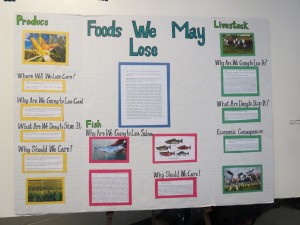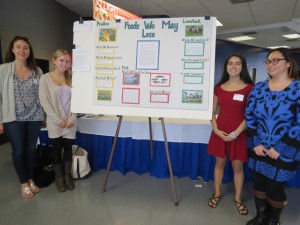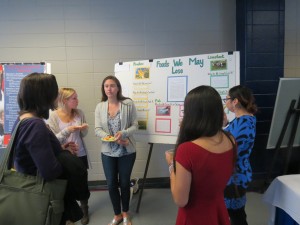Food and Climate Change
Climate change is one of the global issues that has significantly affected various aspects of human life, such as global food security. The negative effects of climate change have led to the decline of quantity, variety, as well as accessibility of the current food produced in different regions of the world. Therefore, it is the goal of our group’s display to promote awareness of the nexus between climate change and global food security under the theme of “Foods We May Lose”. Our group primarily focuses on the three sub-topics: livestock,produce, and fish industries. In order to to provide a clear and concise visual for the visitors, we decided to create a poster board that summarizes ideas and specific examples according to each category that we researched. In addition to this, our poster board also provides information about scholarly resources that we used to compose this display.
Figure 1. Our team

Figure 2. Our Poster Board
Figure 3. Interactive session with visitors
In addition to this, we believe that wasting food is another anthropogenic factor that may lead to the loss of our existing foods, particularly in terms of quantity and accessibility. So, why don’t we try to be more mindful of foods that we currently have and don’t waste them? Moreover, food waste that ends up in landfill also produces methane that amplifies the greenhouse effect (i.e. climate change). The negative feedback goes as the following:
More food waste —> More landfill —> More methane —> More greenhouse gasses —> More climate change —-> More foods that we may lose!
This idea is covered in the following video about food waste made by a member of our group.
Abstract
The purpose of this project is to show how climate change will reduce production and profits in the livestock, produce, and fish industries. Climate change impacts the production, accessibility, stability, diversity, and utilization of food. It is crucial that further research is conducted to find feasible ways to adjust to increasing soil erosion, changes in temperature, increasing carbon dioxide emissions, and extreme weather (Pimentel, 1997). Unsustainable farming practices are dangerous and will result in the decline of public health. As non-organic pesticides are used, and rainfall intensity increases, there is a higher chance of nitrogen runoffs and algae blooms, creating dead zones bodies of water (Diaz & Rosenberg, 2016). Excessive fertilizer use also alters and exhausts the land at faster rates than sustainable practices. As a result, farmers are forced to relocate their production and either dramatically increase or decrease prices, impacting the consumer and putting businesses at risk. Undoubtedly, the food industry and food security are affected by climate change. The predicted increasing temperatures are a catalyst for an incessant cycle of food shortages throughout the world. The predicted negative effects of climate change will force individuals and governments to reconsider how food is distributed to those in need; food prices will increase and families must adjust how they spend their discretionary income (Perner). If climate change continues to be a threat to livestock, produce, and fish, healthy and natural food options will become a rarity, therefore increasing the likelihood of putting small scale, local farms out of business. Consumers will not be able to afford healthy items, therefore leading to the expansion of corporate control. Further, unconsumed food typically ends up in landfills, causing anthropogenic emissions of methane (Miller et al., 2013).
References
Battin, J et al. (2007). Projected Impacts of Climate Change on Salmon Habitat Restoration. Proceedings of the National Academy of Sciences of the United States of America 104 (16), 6720–6725. doi:10.1073/pnas.0701685104.
Beamish, R. J., Noakes, D. J., Mcfarlane, G. A., Klyashtorin, L., Ivanov, V. V., & Kurashov, V. (1999). The regime concept and natural trends in the production of Pacific salmon. Canadian Journal of Fisheries and Aquatic Sciences, 56(3), 516-526. doi:10.1139/f98-200
Beamish, R.J, Riddell, B. E., Lange, K.L.,Farley, E., JR., Kang S., Nagasawa T., Radchenko V. (2009). The Effects of Climate on Pacific salmon – A Summary of Published Literature. North American Anadromous Fish Commission. Retrieved from http://www.npafc.org/new/publications/Special%20Publications/LRMP_Synthesis.pdf
Brander, K. (2007). Global Fish Production and Climate Change. Proceedings of the National Academy of Sciences of the United States of America 104(50), 19709-19714 DOI: 10.1073/pnas.0702059104
Carrington, D. (2014, December 02). Eating less meat essential to curb climate change, says report. Retrieved from http://www.theguardian.com/environment/2014/dec/03/eating-less-meat-curb-climate-change
Cattle on a field [Digital image]. (n.d.). Retrieved from http://www.absorbine.com/blog/wp-content/uploads/2013/07/blog_herefords.jpeg
Corn Field [Digital image]. (n.d.). Retrieved from https://www.flickr.com/photos/16502322@N03/4806634131
Corn and Corn Field [Digital image]. (n.d.). Retrieved from http://arcadiafarmandhome.com/wp-content/uploads/2015/12/corn.jpg
Diaz, Robert J. and Rutger Rosenberg (2008). Spreading Dead Zones and Consequences for Marine Ecosystems. Science, 321, 926-929. doi: 10.1126/science.1156401.
End Food Waste Now. (n.d.). Facts. Retrieved from http://www.endfoodwastenow.org/index.php/resources/facts
Federation of Virginia Food Banks (n.d.). VA Hunger Facts. Retrieved April 2, 2016 from http://vafoodbanks.org/about-hunger/va-hunger-facts/.
Food Tank. (2015, June 5). 10 Facts You Might Not Know About Food Waste | FoodTank.com. Retrieved from http://foodtank.com/news/2015/06/world-environment-day-10-facts-about-food-waste-from-bcfn
Food Waste: The Facts – World Food Day (2015, October 16). Retrieved from http://www.worldfooddayusa.org/food_waste_the_facts.
Hatfield, J and Tackle, G (2014). Agriculture. National Climate Assessment: U.S. Global
Change Research Program. Retreived from April 4, 2016 from http://nca2014.globalchange.gov/report/sectors/agriculture#statement-16364.
Herbut, P & Angrecka, S (2012). Forming of temperature-humidity index (THI) and milk production of cows in the free-stall barn during the period of summer heat. Animal Science Papers and Reports, 30, 363-372. Retrieved April 6, 2016 from http://www.ighz.edu.pl/files/objects/7500/66/pp_363-372.pdf.
Lardy, G. (2013). Feeding Corn to Beef Cattle. North Dakota State University Extension Service. Retrieved April 5, 2016 from https://www.ag.ndsu.edu/pubs/ansci/beef/as1238.pdf.
Global Harvest Initiative (2012, September 14). Livestock plays a vital role in food security. http://www.globalharvestinitiative.org/index.php/2012/09/livestock-plays-a-vital-role-in-food-security/
Maeder, P. et al. (May 2002). Soil Fertility and Biodiversity in Organic Farming, Science, 296 (5573), doi: 10.1126/science.1071148.
Meerman, J & Aphane, J (2012). Introduction of High Food Prices on Nutrition. FAO Nutrition Division, Retrieved April 6, 2016, from http://www.fao.org/fileadmin/user_upload/agn/pdf/Meerman_Aphane_ICN2_FINAL.pdf
Miller, S. M. et al. (2013). Anthropogenic Emissions of Methane in the United States. Proceedings of the National Academy of Sciences, 110 (50). doi:10.1073/pnas.1314392110
Mohanty, B., Mohanty, S., Sahoo, J., & A. (2010). Climate Change: Impacts on Fisheries and Aquaculture. Climate Change and Variability. doi:10.5772/9805
Perner, Lars. Food Marketing. Retrieved from http://www.consumerpsychologist.com/food_marketing.html.
Pimentel, D., Houser, J., Preiss, E., White, O., Fang, H., Mesnick, L., … Alpert, S.. (1997). Water Resources: Agriculture, the Environment, and Society. Bioscience, 47(2), 97–106. http://doi.org/10.2307/1313020
Rabin, K. (2012, August 21). 18 Surprising Facts That Will Motivate You to Stop Wasting Food | Alternet. Retrieved from http://www.alternet.org/food/18-surprising-facts-will-motivate-you-stop-wasting-food
Rand, P. (n.d.). Salmon and Climate Change: Fish in Hot Water. Retrieved from http://www.iucnredlist.org/
Rosenweizg, C., A. Iglesias, X.B. Yang, P. Epstein, and E. Chivan (2001). Climate Change and
Extreme Weather Events: Implication for Food Production, Plant Diseases, and Pests. Global Change and Human Health, 2, 90-104, Retrieved April 6, 2016 http://link.springer.com/article/10.1023%2FA%3A1015086831467?LI=true.
Salmon and Global Warming – National Wildlife Federation. (n.d.). Retrieved from http://www.nwf.org/Wildlife/Threats-to-Wildlife/Global-Warming/Effects-on-Wildlife-and-Habitat/Salmon.aspx
Schimidhuber, J., & Tubiello, F. N. (n.d.). Global food security under climate change (W. Easterling, Ed.). Global Perspective Studies Unit, Food and Agriculture Organization (PNAS). Retrieved March 3, 2007, from http://www.pnas.org/content/104/50/19703.full.pdf
Thayer, J. A., Bertram, D. F., Hatch, S. A., Hipfner, M. J., Slater, L., Sydeman, W. J., & Watanuki, Y. (2008). Forage fish of the Pacific Rim as revealed by diet of a piscivorous seabird: Synchrony and relationships with sea surface temperature. Canadian Journal of Fisheries and Aquatic Sciences, 65(8), 1610-1622. doi:10.1139/f08-076
U.S. Department of State (2014). United States Climate Action Report 2014. Retrieved from http://www.state.gov/documents/organization/219038.pdf
United Nation Environmental Programme. (2013). World Environment Day – Food Waste Facts. Retrieved from http://www.unep.org/wed/2013/quickfacts/
Various Types of Pacific Salmon [Digital image]. (n.d.). Retrieved from http://static1.squarespace.com/static/552eaedce4b0dc86eeb1cddd/t/55f9b98ee4b059c2a5786b05/1442429328207/
Wild Caught Salmon [Creative Commons]. (n.d.).


